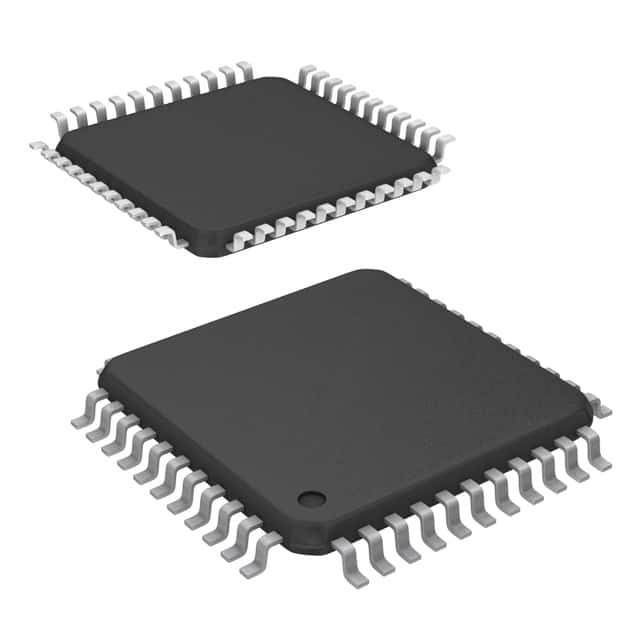Voir les spécifications pour les détails du produit.

EPM3032ATC44-4N
Product Overview
Category
The EPM3032ATC44-4N belongs to the category of programmable logic devices (PLDs).
Use
This device is commonly used in digital circuit design and implementation. It provides a flexible and customizable solution for various applications.
Characteristics
- Programmable: The EPM3032ATC44-4N can be programmed to perform specific functions based on user requirements.
- High Integration: It offers a high level of integration, allowing multiple logic functions to be implemented within a single device.
- Versatile: This PLD supports a wide range of applications due to its programmability.
- Compact Package: The EPM3032ATC44-4N is packaged in a compact 44-pin Thin Quad Flat Pack (TQFP) package.
Packaging/Quantity
The EPM3032ATC44-4N is typically sold in reels or trays containing multiple units. The exact quantity may vary depending on the supplier.
Specifications
- Device Type: Programmable Logic Device (PLD)
- Family: EPM3000
- Number of Macrocells: 32
- Operating Voltage: 3.3V
- Speed Grade: -4
- Package Type: 44-pin TQFP
- Temperature Range: Commercial (0°C to 70°C)
Detailed Pin Configuration
The EPM3032ATC44-4N has a total of 44 pins. Here is a detailed pin configuration:
- VCCIO
- GND
- I/O_0
- I/O_1
- I/O_2
- I/O_3
- I/O_4
- I/O_5
- I/O_6
- I/O_7
- I/O_8
- I/O_9
- I/O_10
- I/O_11
- I/O_12
- I/O_13
- I/O_14
- I/O_15
- I/O_16
- I/O_17
- I/O_18
- I/O_19
- I/O_20
- I/O_21
- I/O_22
- I/O_23
- I/O_24
- I/O_25
- I/O_26
- I/O_27
- I/O_28
- I/O_29
- I/O_30
- I/O_31
- GND
- VCCIO
- TCK
- TMS
- TDI
- TDO
- GND
- VCC
Functional Features
- Flexible Logic Implementation: The EPM3032ATC44-4N allows users to implement custom logic functions, enabling the design of complex digital circuits.
- In-System Programmability: This PLD can be programmed while in operation, allowing for easy updates and modifications without the need for physical replacement.
- High-Speed Operation: The device operates at high speeds, making it suitable for applications that require rapid data processing.
- Low Power Consumption: The EPM3032ATC44-4N is designed to minimize power consumption, making it energy-efficient.
Advantages and Disadvantages
Advantages
- Customizable: The programmable nature of this PLD enables tailored solutions for specific applications.
- Cost-Effective: By eliminating the need for multiple discrete components, the EPM3032ATC44-4N reduces overall system costs.
- Time-Saving: The ability to reprogram the device without physical replacement saves time during development and debugging stages.
Disadvantages
- Learning Curve: Utilizing PLDs requires knowledge of hardware description languages and digital circuit design principles.
- Limited Resources: The number of macrocells and available resources may restrict the complexity of designs that can be implemented.
Working Principles
The EPM3032ATC44-4N utilizes a combination of programmable logic elements, interconnects, and input/output blocks to implement custom logic functions. These elements are interconnected through programmable routing resources, allowing users to define the desired behavior of the device using a hardware description language (HDL) or schematic entry.
Detailed Application Field Plans
The EPM3032ATC44-4N finds applications in various fields, including:
- Communications: Used in networking equipment, routers, and switches for data processing and protocol handling.
- Industrial Automation: Employed in control systems, motor drives, and robotics for implementing complex logic functions.
- Consumer Electronics: Integrated into smart home devices, gaming consoles, and multimedia systems for enhanced functionality
Énumérez 10 questions et réponses courantes liées à l'application de EPM3032ATC44-4N dans les solutions techniques
Sure! Here are 10 common questions and answers related to the application of EPM3032ATC44-4N in technical solutions:
1. What is EPM3032ATC44-4N? - EPM3032ATC44-4N is a specific model of programmable logic device (PLD) manufactured by Altera (now Intel). It belongs to the MAX 3000A family of CPLDs.
2. What is the purpose of EPM3032ATC44-4N? - The purpose of EPM3032ATC44-4N is to provide digital logic functions in various electronic systems. It can be programmed to perform specific tasks or implement complex digital designs.
3. What are the key features of EPM3032ATC44-4N? - Some key features of EPM3032ATC44-4N include 32 macrocells, 32 inputs/outputs, 32 flip-flops, 32 product terms per macrocell, and a maximum frequency of operation of 133 MHz.
4. How is EPM3032ATC44-4N programmed? - EPM3032ATC44-4N can be programmed using a hardware programming tool such as a programmer or through a JTAG interface. The programming file is generated using design software like Quartus Prime.
5. What are some typical applications of EPM3032ATC44-4N? - EPM3032ATC44-4N can be used in various applications such as industrial control systems, communication equipment, automotive electronics, medical devices, and consumer electronics.
6. Can EPM3032ATC44-4N be used for complex designs? - Yes, EPM3032ATC44-4N can be used for implementing complex digital designs. It offers a sufficient number of macrocells, flip-flops, and product terms to handle moderately complex logic functions.
7. What is the power supply requirement for EPM3032ATC44-4N? - EPM3032ATC44-4N requires a single power supply voltage of 3.3V or 5V, depending on the specific version. The datasheet provides detailed information on the power supply requirements.
8. Can EPM3032ATC44-4N be reprogrammed? - No, EPM3032ATC44-4N is not a reprogrammable device. Once it is programmed, the configuration remains fixed until it is replaced with a new programmed device.
9. Is EPM3032ATC44-4N suitable for high-speed applications? - EPM3032ATC44-4N has a maximum frequency of operation of 133 MHz, which makes it suitable for many high-speed applications. However, for extremely demanding applications, other higher-performance devices may be more appropriate.
10. Are there any limitations or considerations when using EPM3032ATC44-4N? - Some considerations include limited macrocell count, limited I/O count, and limited product terms per macrocell. Additionally, it is important to carefully plan and optimize the design to make efficient use of available resources.

